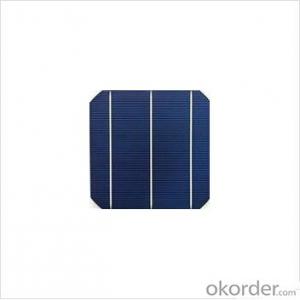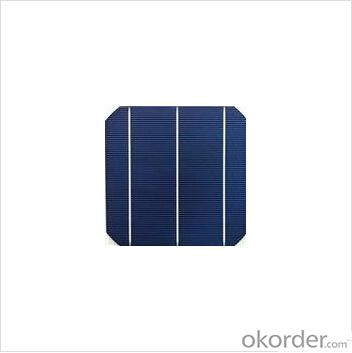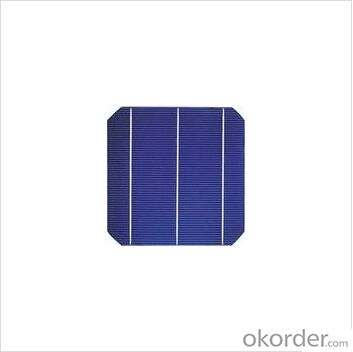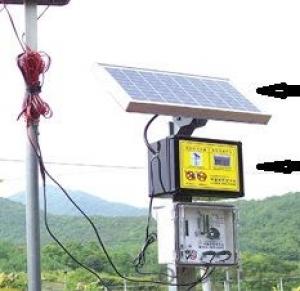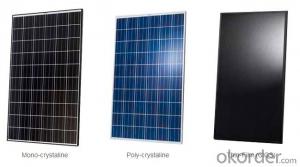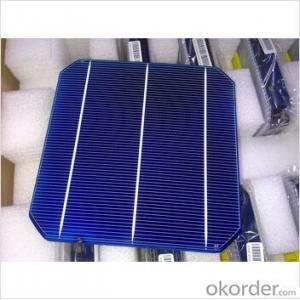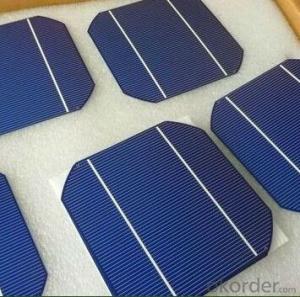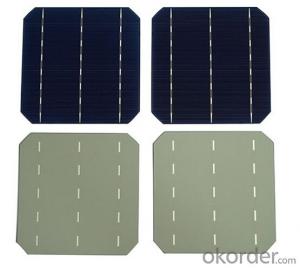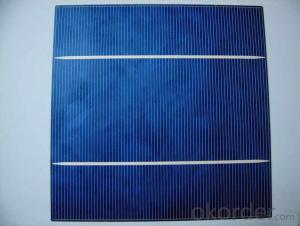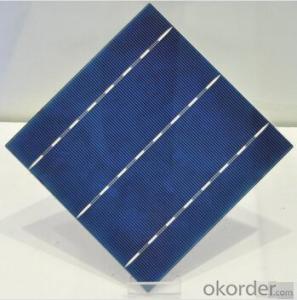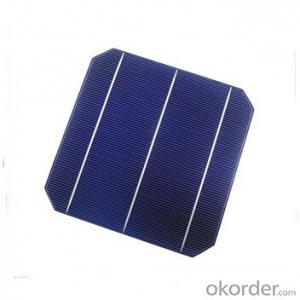High Quality 18.6 Monocrystalline Solar Cells Layers
- Loading Port:
- Shanghai
- Payment Terms:
- TT OR LC
- Min Order Qty:
- 1000 pc
- Supply Capability:
- 1000000 pc/month
OKorder Service Pledge
OKorder Financial Service
You Might Also Like
Solar Cells:
solar cells, when struck by photons of light from the sun, generates an electrical current which can then be used to power DC or AC electrical loads.
A solar cell is made of silicon. Computer chips are made of this same material. Basically, when light strikes the surface of a solar cell some of it is absorbed into the silicon. This light energy bumps the electrons loose and causes energy to flow
Solar cells is made by solar wafer, it has three categories of solar cell right now, monocrystalline polycrystalline and thin film,These cells are entirely based around the concept of PN junction, which is the critical part of solar module, it is the part that can convert the light energy into electricity, the thickness is from 180um to 200um, with even busbars to conduct electricity, textured cell can decrease diffuse reflection; they are often electrically connected and encapsulated as a module. Photovoltaic modules often have a sheet of glass on the front (sun up) side, allowing light to pass while protecting semiconductor wafers from abrasion and impact due to wind-driven debris, rain, hail, etc. Solar cells are also usually connected in series in modules, creating an additive voltage. Connecting cells in parallel will yield a higher current;With high quality and stable quality. Our Cells can greatly improve the performance of Solar Modules.
Features:
High efficiencies up to 16.4%
Proven long term mechanical stability of silicone
Make of highly purified poly silicone
Three bus bars for reduced series resistance and improved module and cell efficiency
Blue anti-reflecting coating ensures improved light absorption and increased efficiency
Acid texturization offers a uniform appearance and virtually invisible crystal structure
Excellent low light behavior for improved energy yield
Specifications
Efficiency code | 1800 | 1820 | 1840 | 1860 | 1880 | 1900 | 1920 | 1940 | 1960 | 1980 | 2000 |
Efficiency(min(%) | 18.0 | 18.2 | 18.4 | 18.6 | 18.8 | 19.0 | 19.2 | 19.4 | 19.6 | 19.8 | 20.0 |
Pmax (W) | 4.30 | 4.35 | 4.40 | 4.44 | 4.49 | 4.54 | 4.59 | 4.64 | 4.68 | 4.73 | 4.78 |
Voc (V) | 0.630 | 0.632 | 0.634 | 0.636 | 0.638 | 0.640 | 0.642 | 0.643 | 0.645 | 0.647 | 0.649 |
Isc (A) | 8.74 | 8.78 | 8.80 | 8.83 | 8.87 | 8.93 | 8.98 | 9.04 | 9.10 | 9.16 | 9.23 |
Imp (A) | 8.27 | 8.37 | 8.44 | 8.49 | 8.55 | 8.61 | 8.67 | 8.73 | 8.79 | 8.85 | 8.91 |
Solar Cells Advantage:
1. High efficiency and High power.
2. Long-term electrical stability.
3. Lowest price and Fastest delivery.
4. Good quality and good service.
5.Bulk supply
6. Good Warranty
7.Big Sale
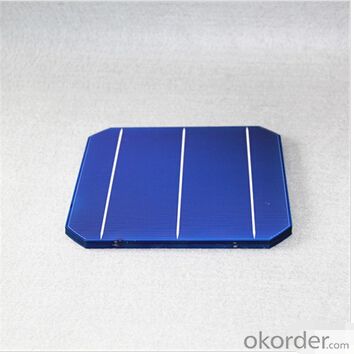
FAQ
We have organized several common questions for our clients,may help you sincerely:
1, What’s price per product ?
A: It’s depends on the quantity, delivery date and payment terms of the order. We can talk further about the detail price issue. Our products is high quality with lower price level.
2, How to make payment?
We accept T/T or L/C.
3, What is your lead time?
Generally 1-5 weeks depends on the order quantity and your specific requirements.
4, Can you do OEM for us?
Yes, we can.
5, How do you pack your products?
We have rich experience on how to pack the panels to make sure the safety on shipment when it arrives at the destination.
- Q: What is the role of solar cells in powering streetlights?
- The role of solar cells in powering streetlights is to capture sunlight and convert it into electricity, which is then stored in batteries. This stored energy is used to power the streetlights during the night, reducing the dependence on the electrical grid and minimizing energy costs and environmental impact.
- Q: What is the role of solar cells in powering outdoor lighting?
- Solar cells play a crucial role in powering outdoor lighting by harnessing sunlight and converting it into electrical energy. These cells, often placed on top of the lighting fixtures, absorb sunlight during the day and store it in rechargeable batteries. As the sun sets, the stored energy is then used to power the outdoor lights, ensuring they illuminate without the need for electricity from the grid. This not only reduces reliance on traditional energy sources but also provides a sustainable and cost-effective solution for lighting outdoor areas.
- Q: How do solar cells generate electricity at night?
- Solar cells do not generate electricity at night as they rely on sunlight to produce energy.
- Q: How do solar cells affect the electric grid?
- Solar cells can have a positive impact on the electric grid by generating clean and renewable energy. When connected to the grid, excess electricity produced by solar cells can be fed back into the grid, reducing the overall demand for electricity. This can help stabilize the grid and decrease the need for traditional fossil fuel-based power plants. Additionally, solar cells can help to decentralize the grid by generating electricity closer to where it is needed, reducing transmission losses and increasing grid resilience.
- Q: What is the role of anti-reflective coatings on solar cells?
- The role of anti-reflective coatings on solar cells is to minimize the reflection of sunlight off the surface of the cells, allowing more light to be absorbed and converted into electricity. This improves the overall efficiency and performance of the solar cells.
- Q: How's the feedback of using 260 watt photovoltaic solar panel? Anybody ever used that?
- the 260 watt photovoltaic solar panel is widely used in the solar cell power supply plant, and my personal feedback is very positive.
- Q: How many types of solar cells are now being used in real life?
- Generally, there are two types of solar cells, one is Monocrystalline silicon solar cells, the other is polycrystalline silicon solar cells
- Q: How do solar cells perform in areas with frequent hurricanes?
- Solar cells can perform well in areas with frequent hurricanes, provided they are properly installed and designed to withstand high winds. It is important to use durable materials and secure mounting systems to ensure their stability during extreme weather events. Additionally, incorporating protective measures such as storm shutters or reinforced frames can help safeguard the solar panels during hurricanes.
- Q: Can solar cells be used in public transportation?
- Yes, solar cells can be used in public transportation. They can be integrated into various parts of vehicles, such as the roof or windows, to generate electricity and reduce the reliance on fossil fuels. This not only helps to reduce emissions and combat climate change but also provides a sustainable and cost-effective solution for powering public transportation.
- Q: What is the role of charge controllers in solar cell systems?
- The role of charge controllers in solar cell systems is to regulate the flow of electrical current between the solar panels and the batteries. They prevent overcharging of the batteries by monitoring the voltage and current levels, ensuring efficient charging and maximizing the lifespan of the batteries. Additionally, charge controllers protect the batteries from being drained excessively by disconnecting the load when the battery voltage drops to a certain level. Overall, charge controllers are crucial in maintaining the integrity and performance of solar cell systems.
Send your message to us
High Quality 18.6 Monocrystalline Solar Cells Layers
- Loading Port:
- Shanghai
- Payment Terms:
- TT OR LC
- Min Order Qty:
- 1000 pc
- Supply Capability:
- 1000000 pc/month
OKorder Service Pledge
OKorder Financial Service
Similar products
Hot products
Hot Searches
Related keywords
